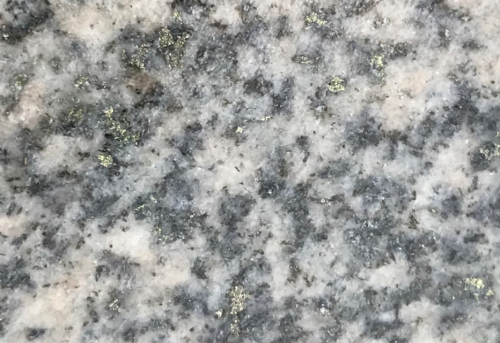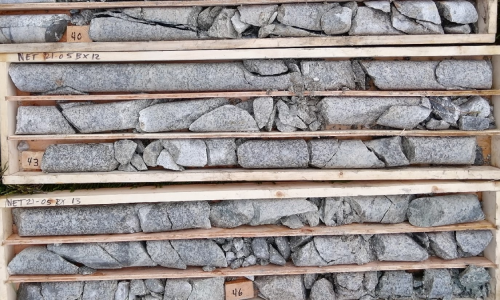August 24, 2021, Vancouver, Canada – Jaxon Mining Inc. (“Jaxon” or the “Company”) (TSX.V: JAX, FSE: 0U31, OTC: JXMNF) is pleased to announce it has completed the fourth and fifth holes (NET21-04 , 357 m in length, 255°/-45° and NET21-05, 97.8 m in length, 282°/-66.5°) at Daisy North Contact Zone at the Netalzul Mt project on the Hazelton Property near Smithers, B.C.
Both NET21-04 and NET21-05 intersected sulfide quartz veining mineralization and disseminated sulfide monzonite porphyry dykes associated with mineralization at Daisy North Contact Zone (Figure 1). Daisy North Contact Zone extends more than 1,200 m (1.2 km) along strike as indicated on surface by outcrops and artisanal workings. The drill core in both holes exhibit patterns of alteration increasing with proximity to the monzonite porphyry dykes and with depth. These results are indicative of the presence of the deeper porphyry system that the Company has been targeting. Geological modeling indicates that the monzonite porphyry dykes were generated by the target porphyry system. The Company’s comparative geological models are being updated to increase the precision of the vectoring exercise in advance of drill testing the porphyry (https://bit.ly/2TSGBqJ).
Hole NET21-04 intercepted two disseminated sulfide monzonite porphyry dyke zones from 39.5 m to 41.0 m and from 152.7 m to 176.3 m; and one high-grade silver-copper-antimony polymetallic sulfide-quartz vein zone from 313.0 m to 323.0 m at the Daisy North Contact Zone (Figures 2-4). Hole NET21-05 drilled only 97.8 m due to a heavily broken faulted zone but intersected one disseminated sulfide monzonite porphyry dyke zone from 33.6 m to 46.6 m and one sulfide quartz veining zone from 62.0 m to 67.0 m from the same drill pad as NET21-04, with a 282-degree north-west orientation and -66.5-degree dip angle (Figure 1).
Highlights of core logging and portable XRF (X-Ray Fluorescence Analyzer) scanning results from NET21-04 and NET21-05 core:
Monzonite Dyke Porphyry Mineralization Zones: Both NET21-04 and NET21-05 intersected disseminated sulfide mineralized monzonite porphyry dykes. The monzonite porphyry dyke zone from 152.7 m to 176.3.0 m at NET21-04 contains disseminated sulfides minerals (Figures 1-3) consisting of more than 20 small (several cm to 1-2 m in width) dykes, with strong potassic feldspar, chlorite, muscovite, secondary biotite and sericite alteration. The sulfide minerals consist of mainly chalcopyrite, pyrite and molybdenite based on the portable XRF testing results in the field. The XRF analyzer at 164.1 m within this zone revealed the existence of Cu element and may represent chalcopyrite and pyrite. Two relatively large monzonite dykes were observed, one spanning one metre from 164.0 m to 165.0 m, and the other from 172.0 m to 174.0 m (Figure 2).
The monzonite porphyry zone from 33.6 m to 46.6 m at NET21-05 contains two disseminated sulfide monzonite dykes and one two-metre granodiorite dyke (Figure 4). The mineral composition is the same as NET21-04, consisting of chalcopyrite, pyrite and molybdenite (Figure 5). XRF analyzer scanning revealed a high percentage of Cu element and may mainly represent chalcopyrite. This monzonite dyke zone may extend to the NET21-04 hole where it spans 1.5 m wide from 39.5 m to 41.0 m (Figure 1).
A clear trend of increasing potassic alteration can be observed in proximity of the monzonite dykes visible in the NET21-04 and NET21-05 cores. It is expected that these small monzonite dykes at the Pad 4 area at Daisy North Contact Zone are derived from one large stock at depth.
High-grade sulfide quartz veining zone: This zone occurs from 313.0 m to 323.0 m at NET21-04 which includes multiple 5 cm to 15 cm thick sulfide-quartz veins (Figure 6) with tetrahedrite, chalcopyrite, pyrite, galena, sphalerite and stibnite, etc. The zone is strongly potassic altered with chlorite, sericite and secondary biotite. Sulfide minerals exist in quartz veins, sulfides veins, or are partially disseminated. Three spot counts at 316.8 m within this zone returned over 296 g/t Ag, 6000 ppm Cu, 2300 ppm Sb and 950 ppm Zn, mainly from tetrahedrite minerals and chalcopyrite (Figure 7). A five-metre sulfide quartz veining zone from 62.0 m to 67.0 m at NET21-05 (Figure 8) presents good Cu and Mo mineralization potential. These sulfide quartz veining zones are being incorporated into the Company’s conceptual resource modelling work; and their commercial potential will be assessed.
Detailed logging of NET21-04 and NET21-05 is currently underway. The rig has been moved to Pad 6 and NET21-06 has been drilled to 181.0 m. The drill has intercepted multiple intense alteration and strong mineralized sulfide quartz veining zones from 52.0 m to 62.0 m, from 105.5m to 109.5 m and from 161.0 m to 175.5 m (Figure 9). The Company’s surface mapping and modeling predict the drill should intersect more high-grade sulfide quartz veining zones as NET21-06 testing continues.
Notice to Reader
The stated widths in metres are downhole core lengths and not true widths. Readers are cautioned that portable XRF (X-Ray Fluorescence) spot counts are not equivalent to laboratory assays; they give an indication of the presence of certain metal elements such as silver, copper, zinc, lead and antimony in the drill cores. Assay results from all cores are pending.
John King Burns, Chairman and CEO of Jaxon Mining, commented, “Based on the drilling results to date, and once confirmed by laboratory assay results, the Company expects to produce a resource model that will support a large polymetallic Cu-Ag-Pb resource. This resource model is expected to be published in the winter of 2021/22 and will be 43-101 compliant.”
“Jaxon is on track to commence a major drill test of the deeper porphyry system at Netalzul Mt. We have collected additional trace element and geophysical data. The team will re-running the models to produce more accurate drill targeting vectors for the porphyry.”
“Our view has always been, and our conceptual geological model indicates, that the source of the metal found closer to surface at Netalzul is a unique porphyry system; unique by virtue of both the intense geochemical and geophysical anomalies that indicate its presence. Our comparative geological modeling indicates that the core of the porphyry lies approximately 800 – 1000 metres in depth under the surface of Netalzul Mt where we are currently drilling. The rig presently on-site is not capable of drilling to this depth. We continue to collect more data and to iterate and refine our targeting models. We are preparing to drill test the porphyry with three more 1,000 metre holes in the fall of 2021 or spring-summer of 2022, dependent on weather, availability of equipment and funding.”

Figure 1. Cross-section of holes NET21-04 and NET21-05 at Pad 4

Figure 2. Core from 164 m to 176 m at NET21-04 showing multiple sulfides monzonite porphyry dykes and potassic alteration.

Figure 3. Cut core at 165.1 m at NET21-04 showing disseminated chalcopyrite and pyrite within monzonite porphyry.

Figure 4. Core from 40 m to 46.6 m at NET21-05 showing sulfides monzonite porphyry dyke.

Figure 5. Core at 41.0 m to 41.2 m at NET21-05 showing disseminated chalcopyrite and pyrite within strong altered monzonite porphyry.

Figure 6. Core from 314.4 m to 320.8 m at NET21-04 showing the multiple sulfide quartz vein zone and intense potassic alteration in the granodiorite.

Figure 7. Three spot counts at 316.8 m returned over 296 g/t Ag, 6000 ppm Cu, 2300 ppm Sb and 950 ppm Zn, mainly from tetrahedrite and chalcopyrite.

Figure 8. Core from 62.0 m to 67.0 m at NET21-05 showing the multiple sulfide quartz vein zone and intense potassic alteration in the granodiorite.

Figure 9. Core from 105.7 m to 109.5 m at NET21-06 showing the strong altered sulfide quartz breccia veining zone in the granodiorite.
Qualified Person
Yingting (Tony) Guo, P.Geo., President and Chief Geologist of Jaxon Mining Inc., a Qualified Person as defined by National Instrument 43-101, has reviewed and prepared the scientific and technical information and verified the data supporting such scientific and technical information contained in this news release.
About Jaxon Mining Inc.
Jaxon Mining is a Canadian-based exploration and development company pursuing the discoveries of commercial scale and grade Cu, Au, Ag, polymetallic projects. Jaxon focuses on overlooked and underexplored targets with deeper intervals that have not been identified or adequately explored; in areas that often have not been systematically mapped, modeled or drilled. Jaxon is currently focused on the Skeena Arch, an exceptionally orogenic and metallogenic area, in one of the most richly endowed terrains in British Columbia. The Company is drilling the Netalzul Mountain project and preparing a drilling program to test the Red Springs project on its 100% controlled Hazelton property.
ON BEHALF OF THE BOARD OF DIRECTORS
JAXON MINING INC.
“John King Burns”
John King Burns, Chairman
For more information please contact:
Investor Relations
Kaye Wynn Consulting
T: 604-558-2630
TF: 1-888-280-8128
E: info@kayewynn.com
Freeform Communications
T: 604-243-0499
E: enquiries@freeform.com
Corporate
T: 604-424-4488
E: info@jaxonmining.com
This news release may contain forward-looking information, which is not comprised of historical facts. Forward-looking information involves risks, uncertainties and other factors that could cause actual events, results, performance, prospects and opportunities to differ materially from those expressed or implied by such forward-looking information. Forward-looking information in this news release may include, but is not limited to, the Company’s objectives, goals or future plans. Factors that could cause actual results to differ materially from such forward-looking information include, but are not limited to, those risks set out in the Company’s public documents filed on SEDAR. Although the Company believes that the assumptions and factors used in preparing the forward-looking information in this news release are reasonable, undue reliance should not be placed on such information, which only applies as of the date of this news release, and no assurance can be given that such events will occur in the disclosed time frames, or at all. The Company disclaims any intention or obligation to update or revise any forward-looking information, whether as a result of new information, future events or otherwise, other than as required by law. Neither TSX Venture exchange nor its Regulations Services Provider (as that term is defined in the policies of the TSX Venture Exchange) accepts responsibility for the adequacy or accuracy of this release.
